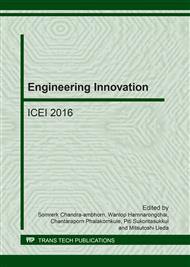p.347
p.353
p.359
p.367
p.373
p.379
p.384
p.390
p.396
Influence of Bagasse Ash as Partial Replacement of Cement on Soft Soil Improvement
Abstract:
Compressive strength of soft soil improvement using cement only and cement partial replacement with bagasse ash were studied. The strength characteristic of stabilized soil was investigated with various curing times of 7, 14 and 28 days. Tested result reveal the stabilized soil strength have trend to increase with time. Using 20% of bagasse ash by dry weight was suggested as optimum content for cement replacement to obtain highest strength. Comparing with cement improved soil, the stabilized soil strength of 20% BA replacement had higher over 25% and modulus of elasticity (E50) was increased up to 37% at 28 days of curing. Change on stabilized soil structure was observed by scanning electron microscopy (SEM) reveal that the formation of hydration reaction product, CSH fabric and rod-like ettringite, have transformed stabilized soil structure denser and harder consequence increase in soil strength with time.
Info:
Periodical:
Pages:
373-378
Citation:
Online since:
January 2017
Authors:
Keywords:
Price:
Сopyright:
© 2017 Trans Tech Publications Ltd. All Rights Reserved
Share:
Citation:


